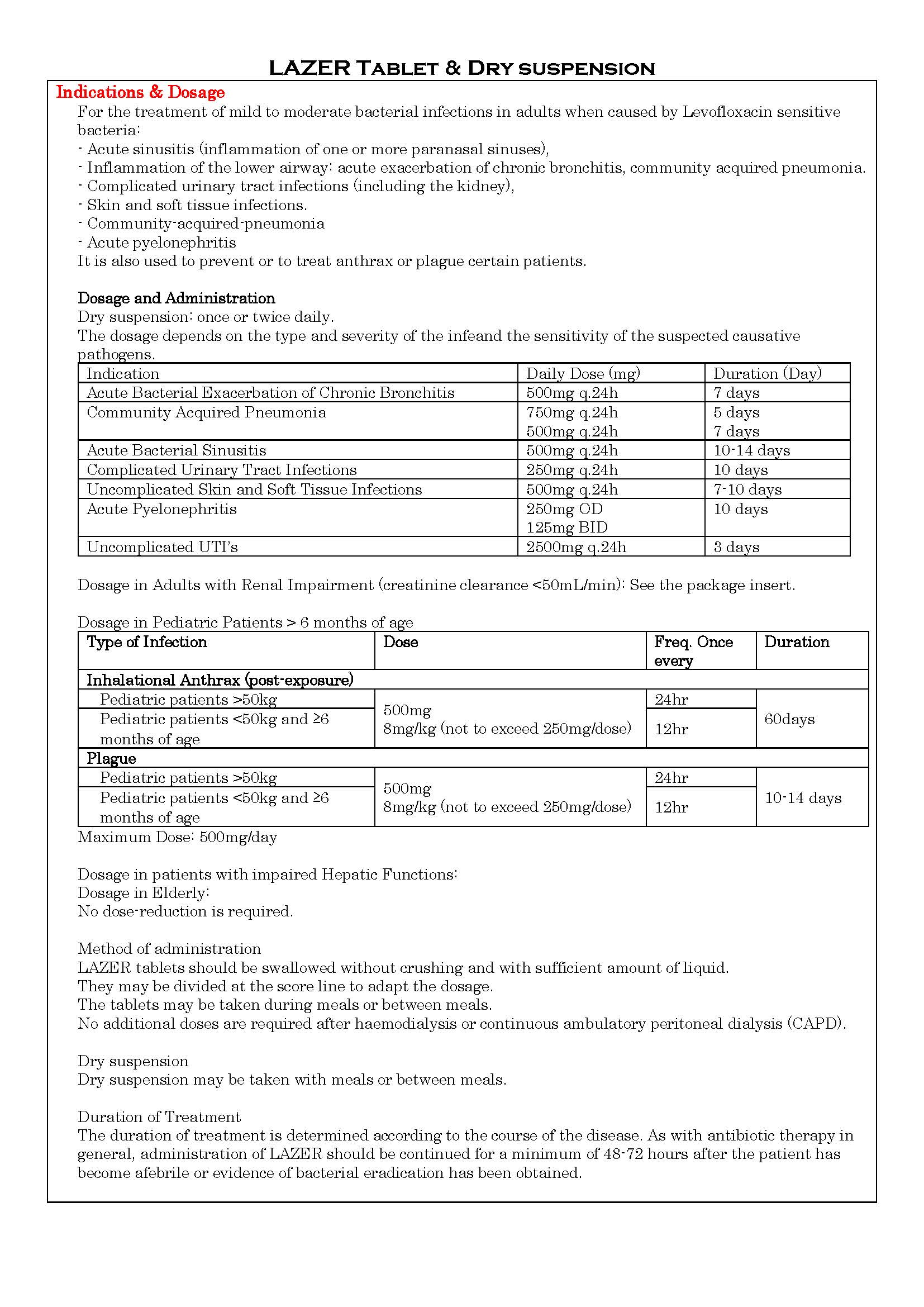LAZER Dry suspension
ក្រុមហ៊ុនផលិតឱសថ:
GENOME PHARMACEUTICALS (PVT.) LTD., Pakistan
- សារធាតុសកម្ម
- ប្រសិទ្ធិភាពព្យាបាល និង កម្រិតប្រើប្រាស់
- ហាមប្រើ
- ផលរំខាន
- អន្តរប្រតិកម្ម
- ស្ត្រីមានផ្ទៃពោះ និង ស្ត្រីបំបៅដោះកូន
- ការប្រុងប្រយ័ត្នជាពិសេស
- សកម្មភាពឱសថ បរិយាយប័ណ្ណឱសថ
-
សារធាតុសកម្ម
1. LAZER 125mg/5mL Dry Suspension:
Levofloxacin 125mg/5mL
2. LAZER 250mg/5mL Dry Suspension:
Levofloxacin 250mg/5mL
-
ប្រសិទ្ធិភាពព្យាបាល និង កម្រិតប្រើប្រាស់

-
ហាមប្រើ
- In person with known hypersensitivity to quinolones or any of the excipients.
- Patient who suffer from epilepsy
- Patient with history of tendon disorders related to treatment with an anti-biotic of fluoro quinolone class.
- Use in Pregnancy and Lactation.
- Neonates.
-
ផលរំខាន
* Skin reactions and general allergic reactions:
Itching and rash. General allergic reactions (anaphylactic/anaphylactoid reaction) with symptoms such as urticaria, cramping of the bronchi and possibly severe breathing problems, as well in very rare cases swelling of the skin and mucous membranes.
* Gastrointestinal Tract/ Metabolism:
Nausea and diarrhoea, loss of appetite, vomiting, pain in the abdominal region, dyspepsia/bloody diarrhoea which in very rare cases may be indicative of enterocolitis, including pseudomembranous colitis.
* Effects on the nervous system:
Headache, vertigo/dizziness, drowsiness, sleeping problems, paraesthesia, e.g., like tingling in the hands, trembling, restlessness, anxiety, convulsions and confusions.
* Effects on cardiovascular system:
Tendon pain including inflammation, joint pain or muscle pain. Tendon ruptures (Achilles Tendon). This side effect may occur within 48 hours after starting treatment and may be bilateral. Muscular weakness, which may be of special importance in patients with myasthenia gravis (a rare disease of nervous system).
* Effects on liver and kidney:
Increased levels of enzymes, (e.g. ALT, AST) increased levels of bilirubin and serum creatinine. Inflammation of the liver, disturbance of kidney function up to kidney failure.
* Effects on the blood:
Increase of certain blood cells (eosinophilia), decreases in the number of white blood cells (leukopenia).
Other reactions:
General weakness, fever. Allergic inflammation of the lung (allergic pneumonitis) or of small blood vessels (vasculitis). Any antibacterial treatment may lead to a disturbance of the micro-organisms that are normally found in humans.
-
អន្តរប្រតិកម្ម
See the package insert about the details below:
Agents which lower the seizure threshold (e.g. theophylline)
Fenbiifen or non-steroidal ailtiphogjstics drugs for treatment of rheumatic diseases)
Sucralfate
Magnesium or aluminum containing antacids
Iron salts
Cimetidine, probenecid
Cyclosporin
-
ស្ត្រីមានផ្ទៃពោះ និង ស្ត្រីបំបៅដោះកូន
Use cautiously.
-
ការប្រុងប្រយ័ត្នជាពិសេស
In cases of severest pneumococcal pneumonia Levofloxacin may not be the optimal therapy. Hospital acquired infections due to certain pathogens (P.aeruginosa) may require combination therapy.
The risk of getting convulsions during the treatment with levofloxacin may be increased if in the past the brain was damaged for example by a stroke or severe brain injury. Therefore inform your doctor completely about your former diseases.
You must not be treated with Levofloxacin if you suffer from epilepsy. The risk of getting convulsions may also be increased by concomitant treatment with fenbufen or comparable nonsteroidal antipalogistics or with theophylline.
Although photosensitization (hypersensitivity to light with sunburn-like reactions) is very rare with administration of Levofloxacin, it is recommended that patients should not expose themselves unnecessarily to strong sunlight or to artificial UV rays (e.g., Sunray lamp, Solarium), in order to prevent photosensitization.
The doctor has to be immediately informed, if severe, persistent and/or body diarrhoea occur during or after treatment with Levofloxacin. These may be symptomatic of a severe inflammation of the intestine (enterocolitis). Induced by the antibiotic treatment. If pseudomembranous colitis is suspected, the treatment with Levofloxacin must be stopped immediately and an appropriate therapy must be initiated without delay. Products inhibiting the peristalsis must not be administered in these cases.
Tendinitis rarely observed with quinolones, may occasionally lead to rupture, involving Achilles tendon in particular. Elderly patients are more prone to tendinitis. The risk of tendon rupture may be increased by coadministration of corticosteroids. If tendinitis is suspected, medical advice is to be asked for immediately, treatment with Levofloxacin must be halted, and the affected tendon must be treated appropriately, e.g., Immobilization, Patties with glucose-6 phosphate dehydrogenase deficiency (a hereditary disease) may be prone to destruction of red blood cells (hemolysis) when treated with quinolone antibacterial agents, and so Levofloxacin should be used with caution in these patients.
Some side effects of Levofloxacin like vertigo/dizziness, drowsiness, and visual disturbances may impair your ability to concentrate and react. This may secure hold). This especially applies of the combination with alcohol.
Levofloxacin must be avoided in patient with known history of mytestenia gravis.
Levofloxacin should be discontinued if the patient develops sign and symptoms hepatitis and jaundice.
Levofloxacin should be discontinued immediately if patient experience symptoms of neuropathy.
Use cautiously in
Bradycardia, acute myocardial ischemia, cirrhosis, renal impairment.
Elderly patients
Pregnant or breast feeding patients
Children younger than 18.
-
សកម្មភាពឱសថ
Levofloxacin is a wide-spectrum antibacterial agent against gram-positive and gram-negative bacteria, including anaerobes. Levofloxacin has shown strong antibacterial activities against. Staphylococcus spp, Streptococcus Pneumoniae, Streptococcus Pyogones, Streptococcus hemolyticus, Enterobacter spp, Escherichia coli, Klebsiella spp, Serratia spp, Enterococcus spp, Proteus spp, and other glucose non fermentative gram-negative rods, Pseudomonas aeruginosa, Haemophilus influenzae, and Neisseria gonorrhoeae.
Levofloxacin has had excellent protective and treatment effects in mice.
The main mechanism of action of Levofloxacin is the inhibition of DNA gyrase. It is 2 folds stronger than that of ofloxacin. There is not much difference between the MIC and MIBC. The activity of LAZER is bactericidal. In the observation of bacterial morphology, bacteriolysis can be seen in the concentration around MIC.
*ព័ត៌មានឱសថត្រូវបានរៀបរៀងដោយ អ៊ីម៉ាតុគឹ មេឌីក (ខេមបូឌា) ដោយផ្អែកលើប្រភពព័ត៌មានខាងក្រោម។ សម្រាប់ព័ត៌មានលម្អិត សូមស្វែងរកនៅក្នុងក្រដាសព័ត៌មាននៃឱសថនីមួយៗ ឬ សាកសួរទៅកាន់ក្រុមហ៊ុនឱសថឬតំណាងចែកចាយនៃឱសថនីមួយៗ។
ប្រភពព័ត៌មាន៖
- ក្រដាសព័ត៌មាននៃឱសថសម្រាប់អ្នកជំនាញវេជ្ជសាស្ត្រដែលប្រើប្រាស់នៅប្រទេសជប៉ុន (Pharmaceutical and Medical Devices Agency, Pmda): https://www.pmda.go.jp
- ព័ត៌មានសង្ខេបនៃឱសថសម្រាប់អ្នកជំងឺដែលប្រើប្រាស់នៅប្រទេសជប៉ុន: http://www.rad-ar.or.jp
